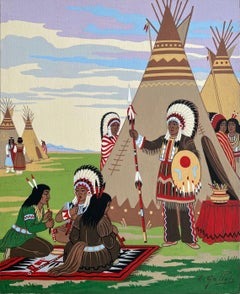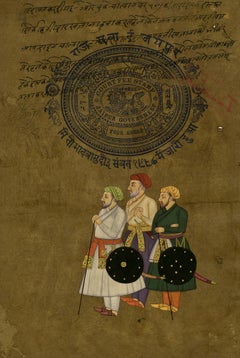Gouache Figurative Drawings and Watercolors
Mid-20th Century American Modern Gouache Figurative Drawings and Watercolors
Gouache
1910s Art Deco Gouache Figurative Drawings and Watercolors
Gouache, Archival Paper, Pencil
1960s Gouache Figurative Drawings and Watercolors
Paper, Gouache
Early 20th Century Gouache Figurative Drawings and Watercolors
Watercolor, Paper, Gouache, Pencil
19th Century Rajput Gouache Figurative Drawings and Watercolors
Gold
15th Century and Earlier Gouache Figurative Drawings and Watercolors
Gouache, Handmade Paper
21st Century and Contemporary Contemporary Gouache Figurative Drawings and Watercolors
Paper, Charcoal, Gouache
2010s Contemporary Gouache Figurative Drawings and Watercolors
Ink, Color Pencil, Gouache, Paper
1920s Art Deco Gouache Figurative Drawings and Watercolors
Gouache
Late 20th Century Gouache Figurative Drawings and Watercolors
Gouache, Watercolor
Mid-20th Century American Modern Gouache Figurative Drawings and Watercolors
Gouache
Mid-20th Century American Modern Gouache Figurative Drawings and Watercolors
Gouache
1950s Gouache Figurative Drawings and Watercolors
Paper, Watercolor, Gouache
Mid-19th Century French School Gouache Figurative Drawings and Watercolors
Paper, Watercolor, Gouache
19th Century Rajput Gouache Figurative Drawings and Watercolors
Gold
1930s American Realist Gouache Figurative Drawings and Watercolors
Paper, Ink, Gouache
Mid-20th Century American Modern Gouache Figurative Drawings and Watercolors
Gouache
Mid-19th Century English School Gouache Figurative Drawings and Watercolors
Watercolor, Gouache
21st Century and Contemporary Contemporary Gouache Figurative Drawings and Watercolors
Paper, Charcoal, Gouache
1910s Jugendstil Gouache Figurative Drawings and Watercolors
Paper, Charcoal, Gouache
1910s Academic Gouache Figurative Drawings and Watercolors
Paper, Watercolor, Gouache
20th Century Gouache Figurative Drawings and Watercolors
Gouache
21st Century and Contemporary Contemporary Gouache Figurative Drawings and Watercolors
Paper, Pencil, Gouache
19th Century Rajput Gouache Figurative Drawings and Watercolors
Gold
1930s American Realist Gouache Figurative Drawings and Watercolors
Gouache, Board
Mid-19th Century French School Gouache Figurative Drawings and Watercolors
Paper, Ink, Gouache
19th Century Rajput Gouache Figurative Drawings and Watercolors
Gold
Mid-20th Century Modern Gouache Figurative Drawings and Watercolors
Gouache
1980s Folk Art Gouache Figurative Drawings and Watercolors
Gouache, Paper
21st Century and Contemporary Contemporary Gouache Figurative Drawings and Watercolors
Paper, Gouache
21st Century and Contemporary Contemporary Gouache Figurative Drawings and Watercolors
Paper, Watercolor, Gouache, Ink
20th Century Art Deco Gouache Figurative Drawings and Watercolors
Gouache
2010s Contemporary Gouache Figurative Drawings and Watercolors
Paper, Ink, Gouache, Color Pencil
19th Century Rajput Gouache Figurative Drawings and Watercolors
Gold
1940s Art Deco Gouache Figurative Drawings and Watercolors
Gouache
1960s Pop Art Gouache Figurative Drawings and Watercolors
Gouache, Offset
1960s Expressionist Gouache Figurative Drawings and Watercolors
Paper, Charcoal, Gouache
1920s Realist Gouache Figurative Drawings and Watercolors
Paper, Watercolor, Ink, Gouache
1930s Impressionist Gouache Figurative Drawings and Watercolors
Paper, Watercolor, Gouache, Pencil
1990s American Realist Gouache Figurative Drawings and Watercolors
Gouache
Early 20th Century Art Deco Gouache Figurative Drawings and Watercolors
Gouache
1890s Victorian Gouache Figurative Drawings and Watercolors
Gouache, Watercolor, Archival Paper
1940s Art Deco Gouache Figurative Drawings and Watercolors
Gouache
1970s Gouache Figurative Drawings and Watercolors
Gouache, Paper
Mid-20th Century Modern Gouache Figurative Drawings and Watercolors
Gouache
1880s Academic Gouache Figurative Drawings and Watercolors
Gouache
1960s Photorealist Gouache Figurative Drawings and Watercolors
Gouache, Illustration Board
1880s Art Nouveau Gouache Figurative Drawings and Watercolors
Ink, Watercolor, Gouache
Mid-20th Century Modern Gouache Figurative Drawings and Watercolors
Gouache
21st Century and Contemporary Contemporary Gouache Figurative Drawings and Watercolors
Ink, Watercolor, Gouache
Mid-20th Century Modern Gouache Figurative Drawings and Watercolors
Gouache
20th Century Gouache Figurative Drawings and Watercolors
Crayon, Pastel, Gouache
21st Century and Contemporary Contemporary Gouache Figurative Drawings and Watercolors
Ink, Watercolor, Gouache
1930s Futurist Gouache Figurative Drawings and Watercolors
Gouache
Mid-20th Century Abstract Gouache Figurative Drawings and Watercolors
Paper, Oil Pastel, Gouache
Mid-20th Century Modern Gouache Figurative Drawings and Watercolors
Watercolor, Gouache
21st Century and Contemporary Contemporary Gouache Figurative Drawings and Watercolors
Paper, Found Objects, Ink, Gouache, Pencil
21st Century and Contemporary Modern Gouache Figurative Drawings and Watercolors
Gouache
20th Century Modern Gouache Figurative Drawings and Watercolors
Paper, Crayon, Watercolor, Gouache
1940s Art Deco Gouache Figurative Drawings and Watercolors
Gouache



